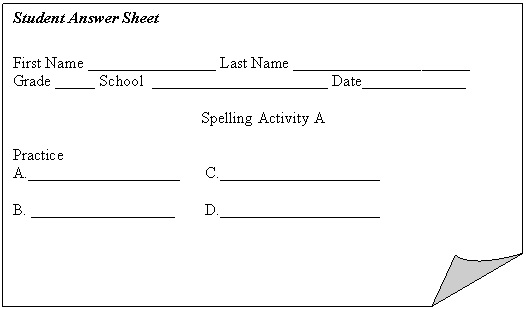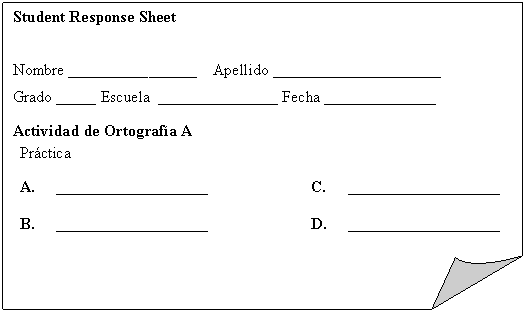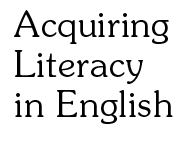Acquiring Literacy in English:
Crosslinguistic, Intralinguistic, and Developmental Factors
Developmental Contrastive Spelling Test
Author and Date
Elizabeth Howard, Julie Sugarman, Igone Artegoitia, and Silvia Caglarcan, Center for Applied Linguistics. 2002.
Purpose
The Spanish and English versions of the Developmental Contrastive Spelling Test were developed to investigate the Spanish and English spelling development of Spanish-English bilingual children with a particular emphasis on potential cross-linguistic influences. The test was developed for the research study Spelling as an Indicator of English Literacy Development, subproject 3 of Acquiring Literacy in English: Crosslinguistic, Intralinguistic, and Developmental Factors.
Age or Grade of Examinees
The assessments were developed to be used with students in grades 2 through 5.
Description
Each test consists of two types of tasks. The first section follows a traditional spelling test format. In this section, a series of real words are dictated to the children both in isolation and embedded in sentences, and the children are asked to spell these words in their entirety. The second section follows a cloze format. In this section, a series of pseudowords are dictated to the children, and children are asked to fill in the missing letters of the partially written pseudoword.
Example from Section 1 (English)
Researcher Sheet
No. |
Word |
Sentence | Word |
|---|---|---|---|
A |
kid |
A new kid visited the school this morning. | kid |
B |
cats |
In America most cats are indoor animals. | cats |
C |
ride |
This year I will ride a horse at the fair. | ride |
D |
soap |
Washing your hands with soap kills the germs. | soap |

Example from Section 2 (English)
No. |
Researcher says... |
Child sees... |
A. |
lat |
l______ |
B. |
framp |
fr______ |
C. |
prishing |
pr______ing |
D. |
flacket |
____cket |
Example from Section 1 (Spanish)
Researcher Sheet
No. |
Word |
Sentence | Word |
|---|---|---|---|
A |
amigo |
Mi amigo vive en California. | amigo |
B |
mesa |
Mi mamá pone flores sobre la mesa. | mesa |
C |
leo |
Yo leo cuentos de niños. | leo |
D |
gato |
Mi gato come pescado. | gato |

Example from Section 2 (Spanish):
No. |
Researcher says... |
Child sees... |
A. |
tamo |
ta______ |
B. |
lacha |
______cha |
C. |
relinta |
re______ta |
D. |
feponi |
______poni |
Administration
The test is group administered by trained native speakers of Spanish and English, respectively. The assessment takes approximately 45 minutes to administer.
Scoring and Interpretation
Items are scored both at the whole-word level and at the feature level. In some cases, partial credit is awarded for items that are spelled incorrectly but constitute a logical phonological representation of the target word (i.e., ‘legal errors’), as in, for example, sead for seed or sevoya for cebolla (‘onion’). Otherwise, words and features are scored as either entirely correct or entirely incorrect.
Reliability and Validity
For the English version of the test, a reliability of .94 was obtained for the pilot version of the real words section while a reliability of .99 was obtained for the pseudowords section. Both reliability coefficients were obtained through a Rasch analysis.
For the Spanish version of the test, a reliability of .93 was obtained for the pilot version of the real words section while a reliability of .98 was obtained for the pseudowords section. Both reliability coefficients were obtained through a Rasch analysis.
Validation data are pending.
Sources
The researchers consulted the following resources in the development of the English and Spanish versions of the test:
Bruck, M., Treiman, R, Caravolas, M., Genesee, F., & Cassar, M. (1998). Spelling skills of children in whole language and phonics classrooms. Applied Psycholinguistics, 19 (4), 669-84.
Fashola, O. S., Drum, P. A., Mayer, R. E., & Kang, S. (1996). A cognitive theory of orthographic transitioning: Predictable errors in how Spanish-speaking children spell English words. American Educational Research Journal, 33(4), 825-43.
Availability
The Developmental Contrastive Spelling Test is available from the Center for Applied Linguistics. To request a copy, complete and submit the Application Form for Use of ALE Researcher-developed Assessment Instruments, available in Microsoft Word and Adobe PDF format.
Citation
Researchers using the Developmental Contrastive Spelling Test should cite it as follows:
Center for Applied Linguistics. (2002). Developmental Contrastive Spelling Test—English. Washington, DC: Author.
Center for Applied Linguistics. (2002). Developmental Contrastive Spelling Test—Spanish. Washington, DC: Author.

